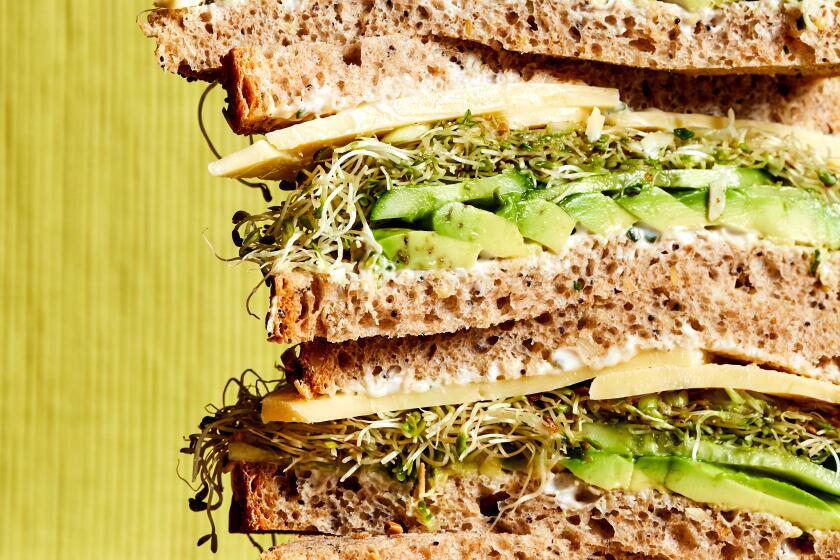Jonathan Gold’s 10 best dishes of 2015
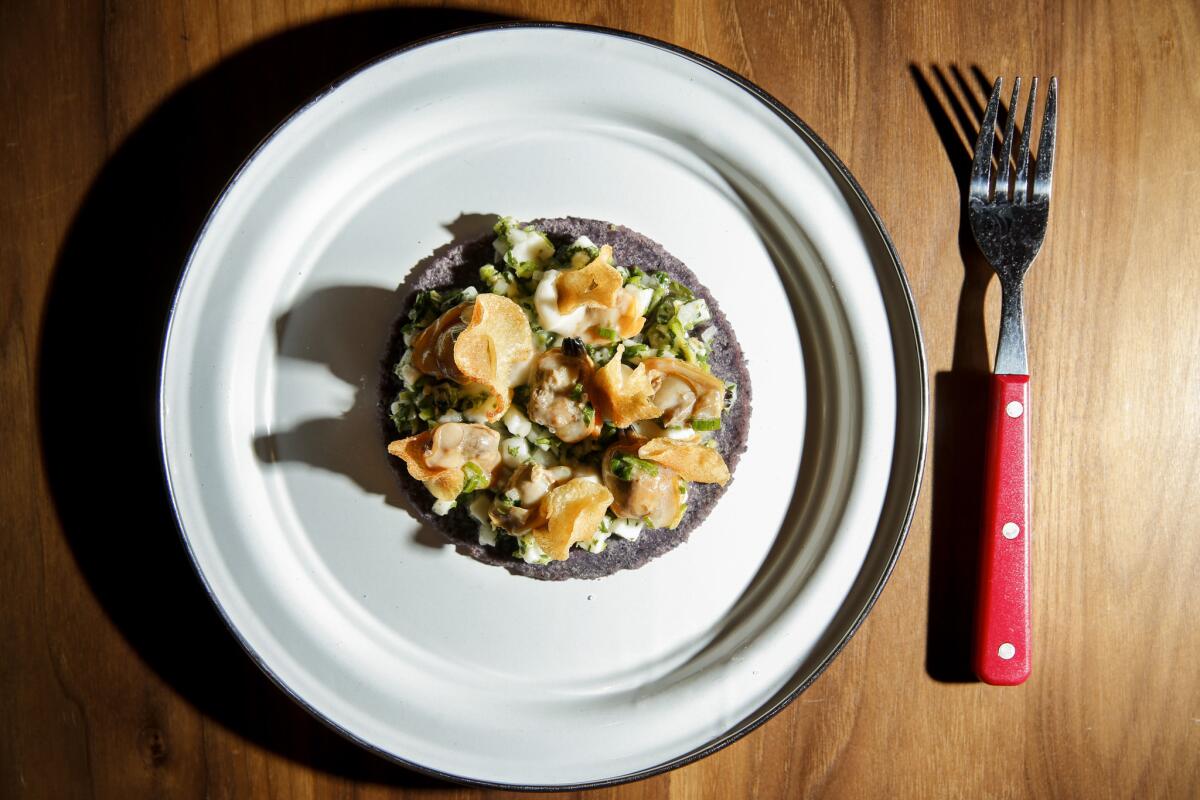
A decade or two from now, when line-caught sea bass will seem as rare and unobtainable as sturgeon caviar is now, drive-through windows sell more lentil bowls than cheeseburgers and we have gotten used to the idea of Taylor Swift as the governor of Pennsylvania, 2015 may well seem in retrospect a fairly important year in Los Angeles restaurants. Menus just seemed to be mostly vegetarian without anybody talking about it much, and even French chefs began to talk among themselves about the primacy of Mexican cooking. The differences between high and low cuisine, which had started to crumble as far back as the 1980s, were utterly annihilated. Exotic fermentation techniques began to creep out of the lab. The idea of abolishing the practice of tipping took hold. And as always, there were 10 dishes that attempted to encapsulate it all.
Foie gras funnel cake
In the Food section, we take a special delight in the Frankensteinian creations that have risen in the wake of the Cronut, from the Ramen Burger to the scrapple waffle to the Spam-kimchi croissant. The carrot dog or the cruffin? We’re there. But none of the hybrids, at least on paper, seemed to be quite so far out as foie gras funnel cake, which is a brunch specialty at Timothy Hollingsworth’s brand-new Broad museum-adjacent restaurant Otium. Just the sound of it makes you shudder — one imagines something dank and livery from the guy who deep-fries Twinkies and sticks of butter at the county fair. But the funnel cake, which looks like a pizza-size Iranian jalebi, is actually crisp and delicious, scattered with strawberries, shaved fennel and what look like baby beet leaves hiding delicate, airy puffs of foie gras mousse. I’m not fond of the concept of decadence when it comes to food, but this is real end of empire stuff, the brunch of time’s demise. But you’ll probably just have another cup of iced matcha, then head next door to look at the Koonses and the Infinity Room. 222 S. Hope St., Los Angeles, (213) 935-8500, otiumla.com
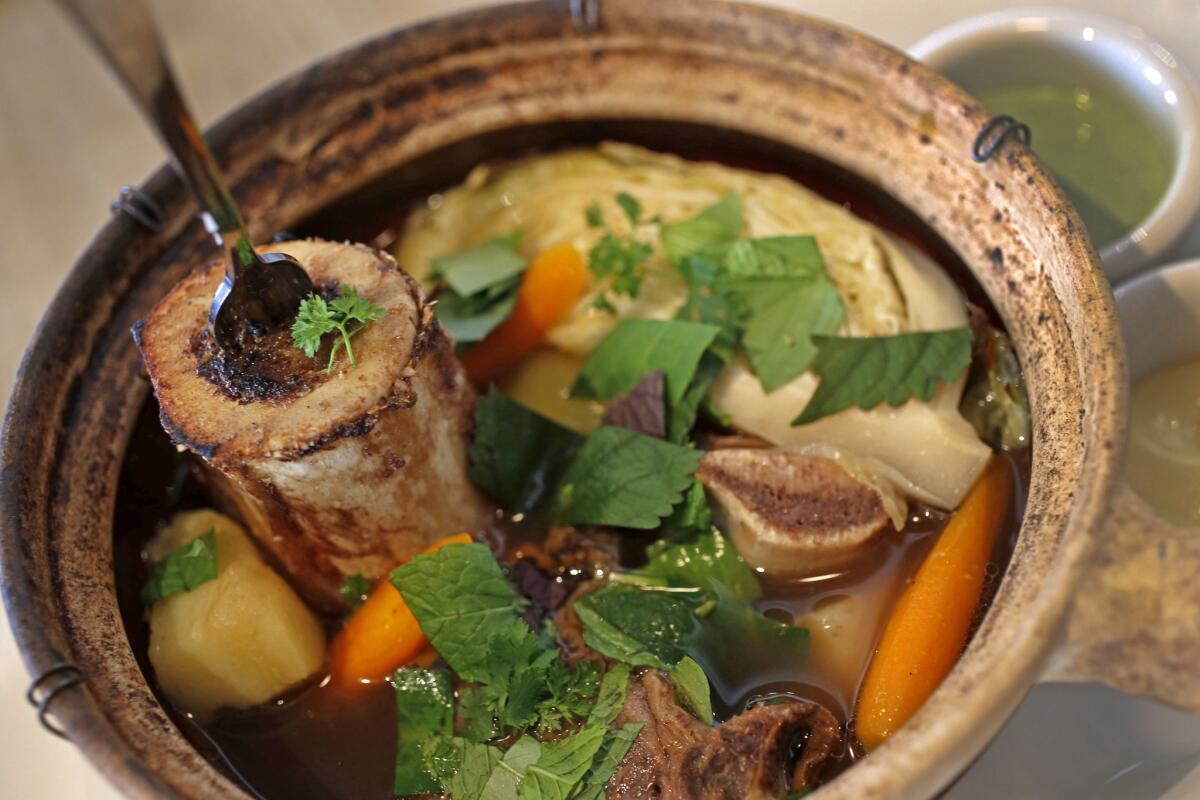
Pho pot-au-feu
The pot-au-feu at Cassia is at first glance indistinguishable from the classic French version — the enduring symbol of French heart and home. There are short ribs gently simmered in broth; potatoes and carrots; a marrowbone jutting from the tureen and even a little dish of mustard. But it is served in a Chinese sandy pot, the kind you’ve seen in a million Hong Kong-style restaurants. The consommé is clear and strong, but it is scented with the burnt onion, cinnamon and star anise of a Vietnamese pho (which was probably in some way derived from the colonial pot-au-feu in the first place). In place of coarse salt and cornichons, you find a scattering of chopped Vietnamese herbs. And while it is not quite clear whether you are supposed to lift the meat and the vegetables from the broth onto the plate as one would with a traditional pot-au-feu — the waiters provide no guidance — or whether you are supposed to pry the marrow from its bone with the provided oyster fork and smear it on grilled bread, the pot-au-feu is brilliant and soothing. Chef Bryant Ng, trained at the Cordon Bleu in Paris, is claiming the essence of French cooking as his own; colonizing the colonizers at last. 1314 7th St., Santa Monica, (310) 393-6699, cassiala.com
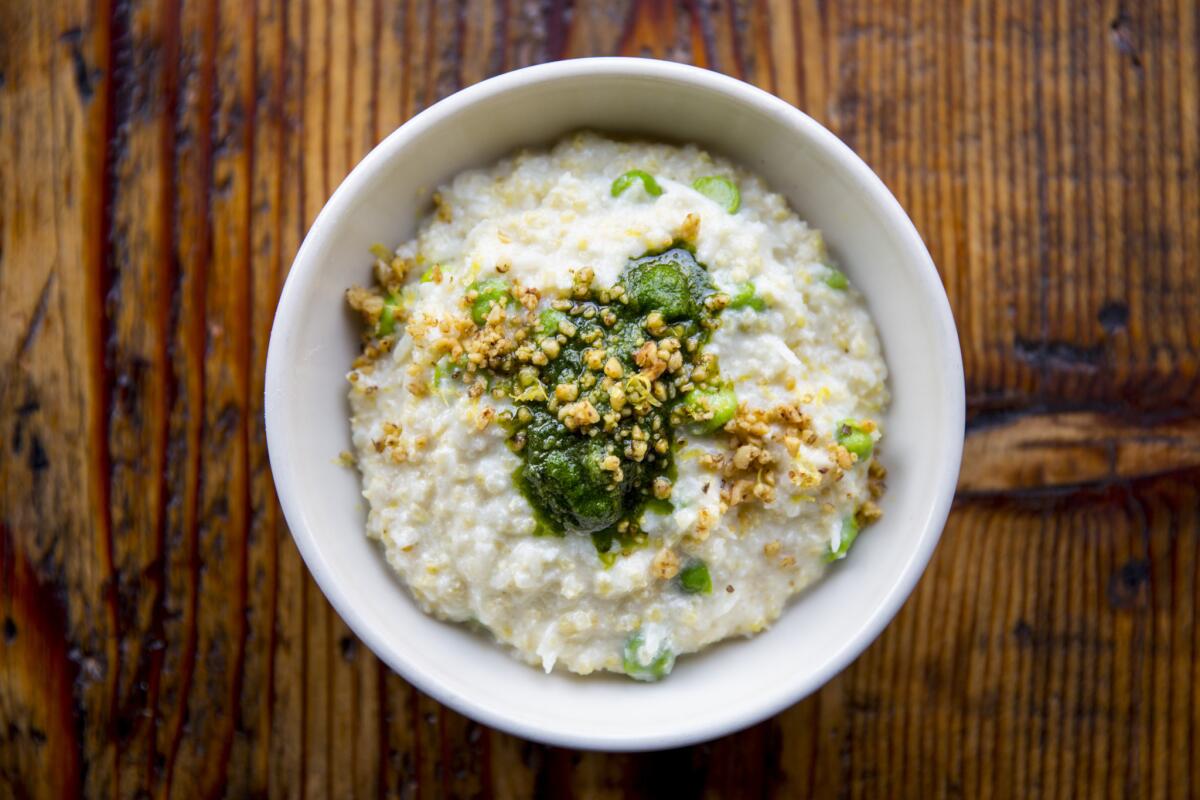
Cauliflower and millet
Odys + Penelope, run by Quinn and Karen Hatfield, is a chefly homage to the Brazilian churrascaria; wood-roasted picanha, fraldinha and mammoth short ribs, but served with things like Bernaise sauce or puréed carrots instead of chimichurri. Still, the best thing on the menu may be the bowl of cauliflower and millet painted with a sharp, almond-basil purée. How do the Hatfields coax the locker-room funkiness of cauliflower into sweet, nuanced nuttiness? How is it possible to tame such disparate ingredients into a smooth porridge? Does the creamy richness come from a lashing of ricotta, is it a blender trick, or have the chefs discovered a way to coax the texture from starchy stirred millet the way an Italian chef might from Arborio rice? I’ve had the dish half a dozen times by now and I still can’t tell you — the question may require months of further study, hurried along by quite a lot of Beaujolais. 127 S. La Brea Ave., Los Angeles, (323) 939-1033, odysandpenelope.com
SIGN UP for Jonathan Gold’s Counter Intelligence dining newsletter >>

Clam-lardo tacos
Ray Garcia is probably L.A.’s breakout chef of the year. His streamlined cuisine powers two new major restaurants downtown, and he almost single-handedly snatched the idea of Mexican-American cooking back from those who would identify it with hard-shell tacos and combination dinners. But in some circles it seems as if all anybody talks about is his taco with lardo and clams, the improbable specialty of B.S. Taqueria. The tortillas, for one thing, are heavy and thick, pressed to order from specially imported GMO-free corn. There is an Italian-style gremolata flavored with minced lardo — cured back fat from sustainably raised hogs — as well as a handful of gently warmed clams and a drizzle of melted fat. And when you pick up the taco, what pours out is the pure, briny essence of the barnyard and the sea, a razor-sharp chile heat and just a trickle of citrus. The taco is all pork, and yet... all clam. 514 W. 7th St., Los Angeles, (213) 622-3744, bstaqueria.com
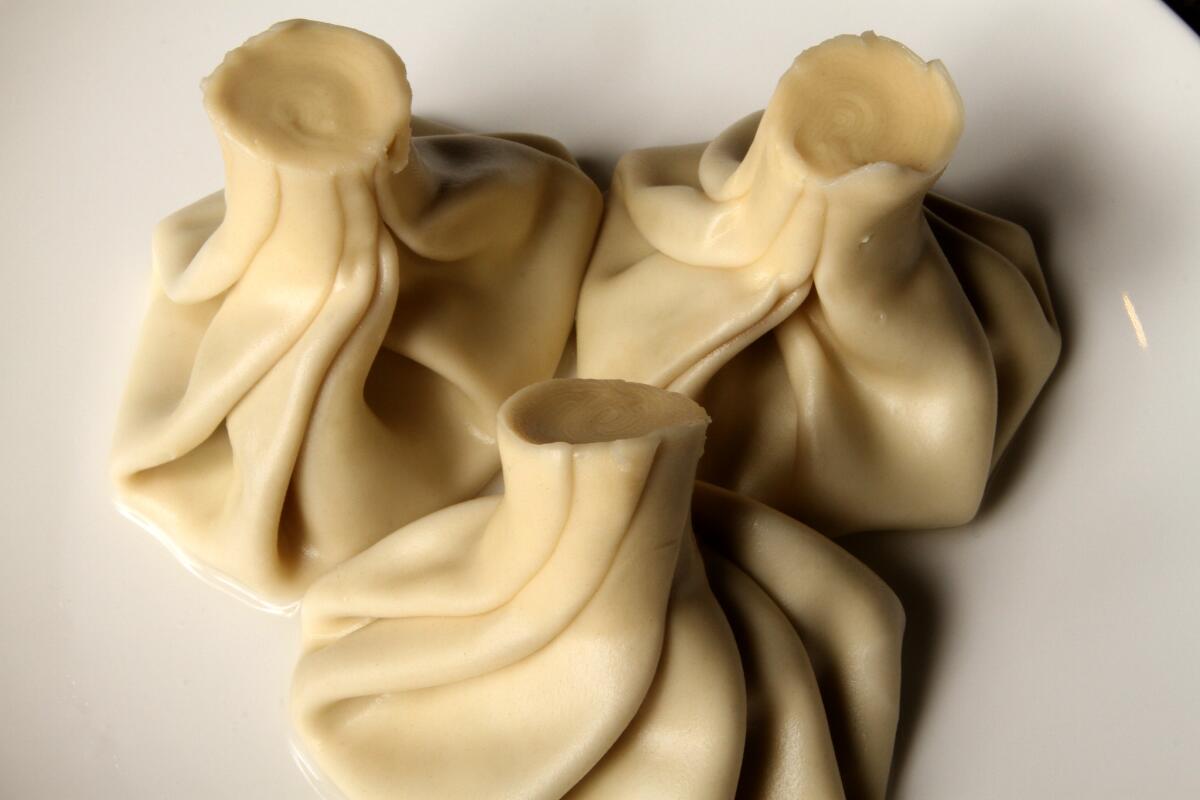
Khinkali
Khinkali are soup dumplings from the mountains north of Tbilisi, Georgia. A proper example is about the size and heft of a lemon; a lump of oniony meat encased in a sturdy pleated wrapper gathered at the top in a thick, doughy knob. You will find these khinkali at Tumanyan Khinkali Factory, a branch of the most famous khinkali restaurant in Armenia’s capital, Yerevan. Remember the first time you faced down a plate of pork and crab dumplings at Din Tai Fung? It’s like that: You grab one by its knob, which will be the only part cool enough to touch; you bite off a bit of the top and suck down the boiling juice, and you finish the rest in one or two glorious, meaty bites. You will find that you still have that knob between your fingers. It is technically edible but don’t bother. The pile of spent knobs on your plate, like the pile of empty shells at a clambake, is a sign of an hour well spent. 113 N. Maryland Ave., Glendale, (818) 649-1015, tkfrestaurant.com

Noorook
Are you temperamentally opposed to the idea of a pink, creamy plate of mold? Good. Because the mold in question is Aspergillus oryzae, which has been used to kick off fermentations in Asia for centuries. The Japanese call their version koji and use it to make miso, natto, soy sauce and sake; the Koreans — as well as the intriguing new restaurant Baroo — call it noorook and use it to make the rice wine makgeolli. At Baroo, of course, you are served neither a plate of pure mold, nor really a bowl of moldy things. The noorook here is a lumpy, herb-strewn gruel, dyed a sort of pinky brown with beets, savory and slightly tart, and the lumps are carefully fermented grains. The slight nuttiness also seems to have little to do with actual nuts, although the dish does contain toasted sunflower seeds and chunks of soaked macadamia nuts for texture. There is reduced seaweed broth in there too, if you’re keeping score, and a chip of some sort, and pink onions scented with rose petals. Noorook tastes like nothing you have ever come across. But it does taste like the future. 5706 Santa Monica Blvd., Los Angeles, (323) 819-4344, baroola.strikingly.com
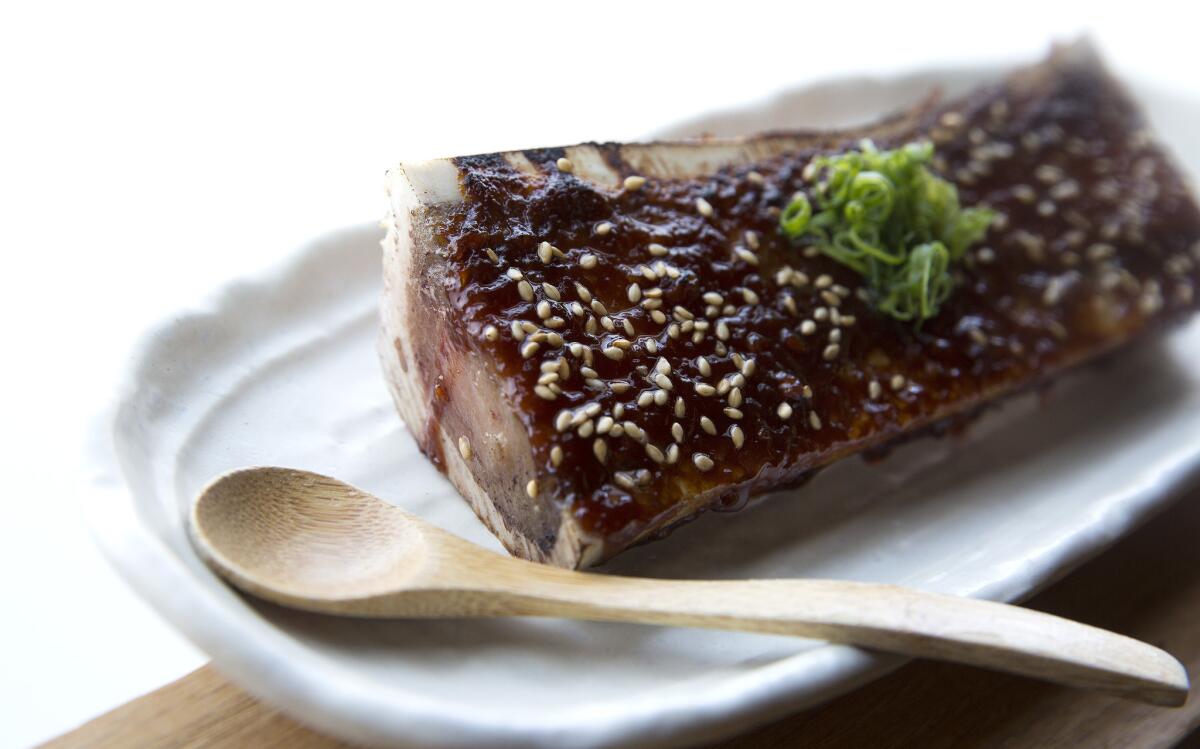
Bone-marrow dengaku
At Kinjiro, the meaty, sake-intensive izakaya downtown, nasu dengaku, a popular summertime dish of halved Japanese eggplants broiled under a thick, sweet miso glaze, becomes bone marrow dengaku. The miso bubbles and caramelizes beautifully on the sawn bones. The half-melted marrow, searingly hot, has a similar softness to the vegetable and carries the sweetness as beautifully, but is almost infinitely rich. A spoonful or so will do, smeared onto toast. This dengaku is pretty intense. The dish is especially popular with visitors from Japan. Bone marrow is apparently still banned there, a relic of the brief mad-cow scare, but the taste for it lingers on. 424 E 2nd St., Los Angeles (in the Honda Plaza), (213) 229-8200, kinjiro-la.com

Phat Thai
The specialty at Pok Pok Phat Thai may be the one Thai dish your great-aunt is likely to have opinions about — a noodle usually characterized by sugary sweetness and fistfuls of bean sprouts. To Thai people, the question of what a great plate of phat Thai might entail is probably about as interesting as the aesthetics of a tuna-salad sandwich might be to an average American. But at Andy Ricker’s food-court restaurant, the little sister to the huge Pok Pok up the street, the noodles are soft and warm, larded with crunchy bits of fried pigskin and flavored with a splash of tamarind and the rendered pork fat in which it has been fried. And in its plainness, it is almost like a blank coloring book — you fill the flavors in yourself with splashes of tiny bird peppers in fish sauce and sliced chiles in vinegar, a dusting of ground dried chile, a spritz of lime and a bit of sugar: no more, no less. And when you get the seasonings right — don’t skimp on the sugar — the noodles explode into loveliness, like the phat Thais you’ve grown up on only better, perhaps because the noodles have been sautéed over a low flame rather than blasted with maximum heat. It may be lunch, but it is also a lesson in taste. 727 N. Broadway, No. 130, Los Angeles, (213) 628-3071, pokpokphatthaila.com
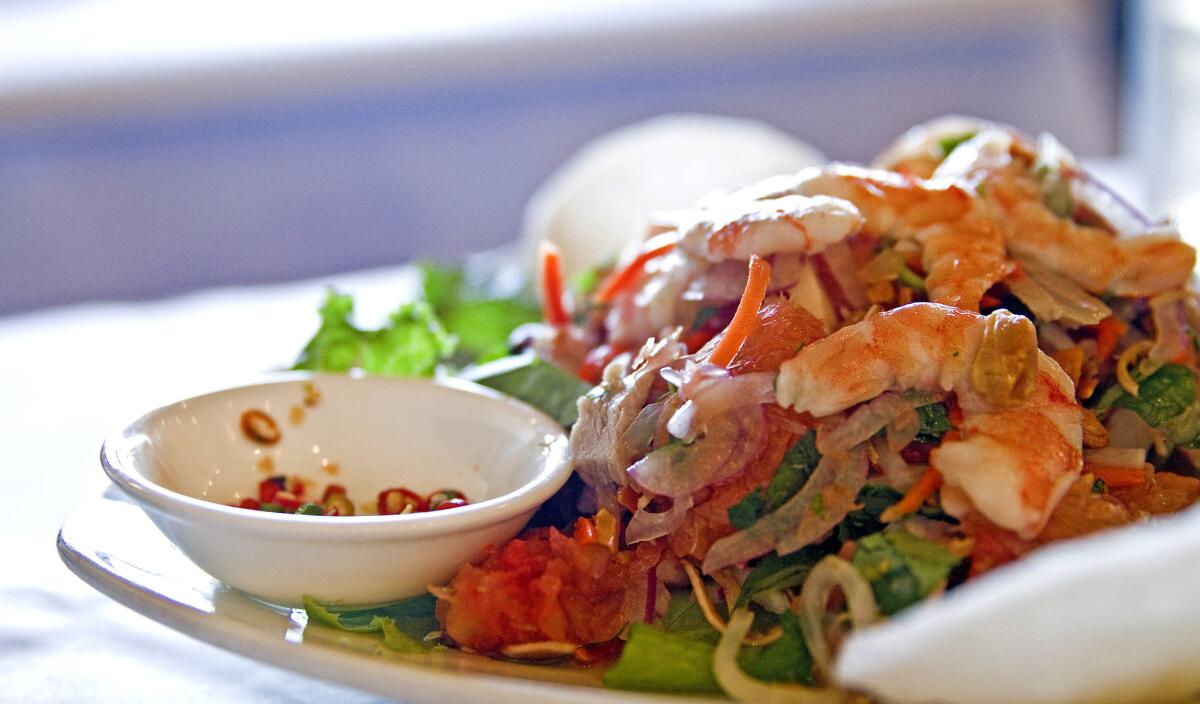
Pomelo salad
Garlic & Chives may be something like a modern small-plates restaurant, but it is also very Vietnamese, from the sweetness of Kristin Nguyen’s crisply fried salmon belly to the platters of grilled blood clams in their shells, from the julienne of sweet beef jerky in the green papaya salad to the chewy curls of skin in the goat curry and its accompanying hot baguette. Even in the corner of the U.S. richest in options for Vietnamese food, you will always find a line at Garlic & Chives. Could the best thing there be the simple, herby salad of pomelo segments tossed with roasted peanuts, slivers of banana blossom and a little fish sauce? It is certainly the most refreshing. 9892 Westminster Blvd., No. 311, Garden Grove, (714) 591-5196
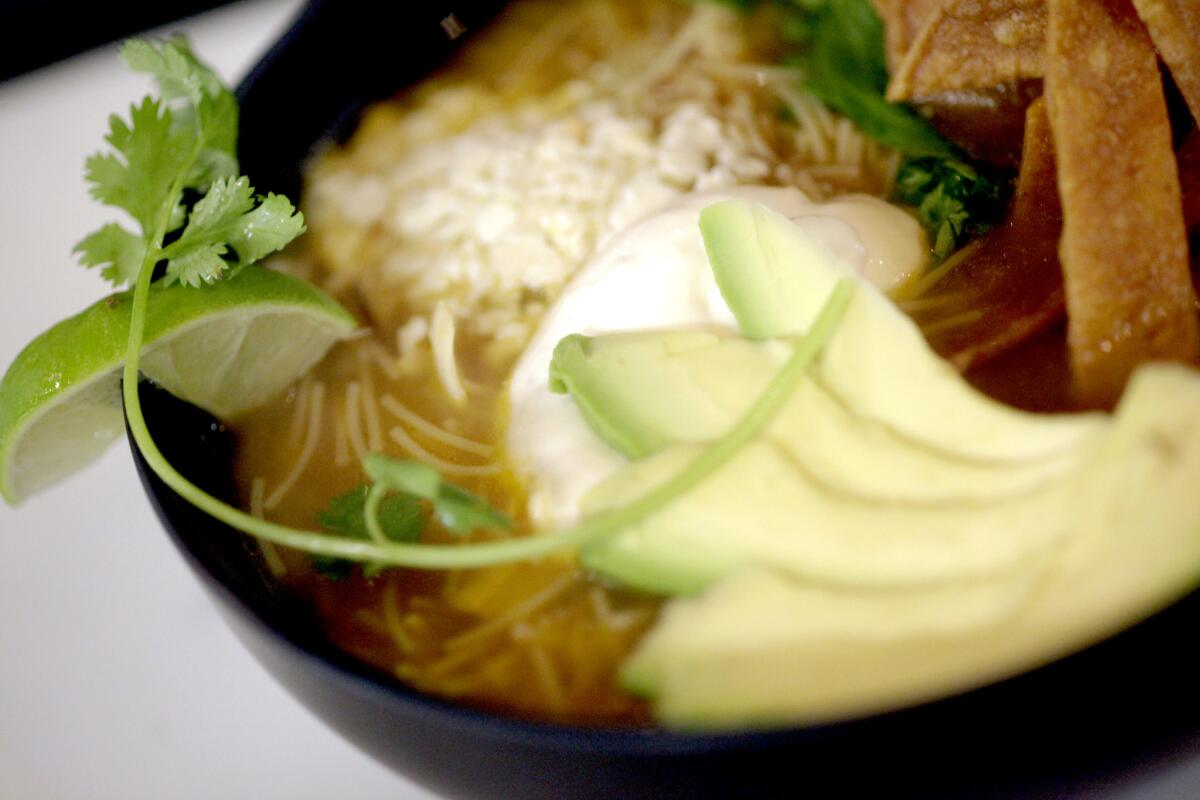
Fideo
If a Mexican restaurant served only one dish, fideo is exactly what you’d want it to be. Fideo is made with thin noodles, a bit like vermicelli, that are traditionally broken into manageable pieces and toasted in oil before being introduced to simmering broth. In Spain, fideo is basically an alternate form of paella. In Mexico and the Mexican diaspora, where it is synonymous with home cooking, it is more of a soup, but almost infinitely customizable, with almost any kind of chile, meat, vegetable or garnish a cook could imagine. So when you settle into a booth at Colonia Publica, you are handed a checklist, like the kind you see at some ramen shops, asking exactly what you would like to put into your basic bowl (which you can get vegetarian if you like): chicken, shrimp or smoked sausage; crunchy fried pork rinds or greasy crumbles of chorizo; mushrooms or queso fresco; chopped chiles or juicy pico de gallo — or possibly all of the above. 6717 Greenleaf Ave., Whittier, (562) 693-2621
ALSO:
Jonathan Gold’s 101 Best L.A.-area Restaurants
VIDEO: Jonathan Gold’s Los Angeles -- Cheddar Bacon Biscuit
Review: Trois Familia, where the Trois Mec chef makes Mexican brunch
More to Read
Eat your way across L.A.
Get our weekly Tasting Notes newsletter for reviews, news and more.
You may occasionally receive promotional content from the Los Angeles Times.








